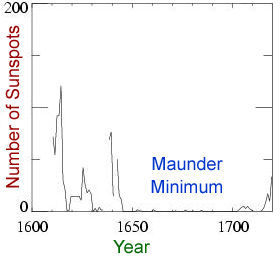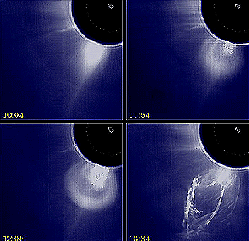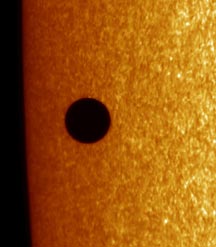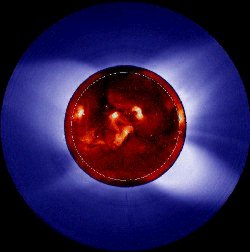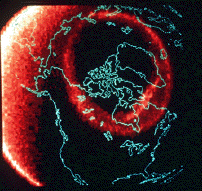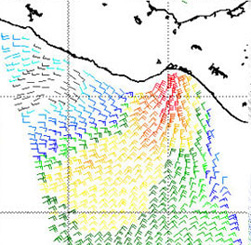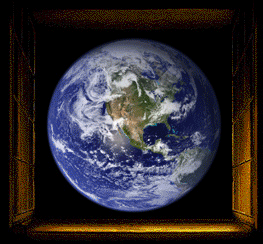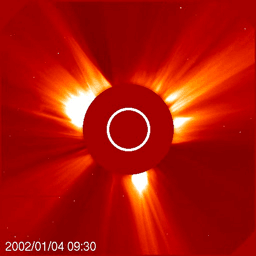Click on image for full size
Image courtesy NASA (modified by Windows to the Universe staff).
History of Sunspot Observations
Surprisingly, humans have observed sunspots for a very long time, so historical sunspot observations provide us with some of our best long-duration records of solar activity. Large sunspots can sometimes be seen with the naked eye, especially when the Sun is viewed through fog near the horizon at sunrise or sunset. (WARNING: Never look directly at the Sun! Even a brief glance can damage your eyes!) The first written record of sunspots was made by Chinese astronomers around 800 B.C. Court astrologers in ancient China and Korea, who believed sunspots foretold important events, kept sporadic records of sunspots for hundred of years. An English monk named John of Worcester made the first drawing of sunspots in December 1128.
Soon after the invention of the telescope, several astronomers made the first telescopic observations of sunspots. Galileo Galilei in Italy, Johann Goldsmid (a.k.a. Fabricius) in Holland, Thomas Harriot in England, and Christoph Scheiner in Germany all viewed sunspots through telescopes between 1610 and 1613. Astronomers of that era weren't quite sure what to make of these spots on the Sun; some thought they were silhouettes of previously undiscovered planets transiting the Sun as they orbited closer than Mercury, while others believed they were dark clouds in the Sun's atmosphere. The progression of sunspots across the face of the Sun allowed early seventeenth century astronomers to make the first estimates of the Sun's rotation period (about 27 days).
Very few sunspots were seen from about 1645 to 1715, a period referred to as the Maunder Minimum after the English astronomer Edward W. Maunder who studied this unusual time of solar inactivity. This period corresponds to the middle of a series of exceptionally cold winters throughout Europe known as the Little Ice Age. Scientists still debate whether decreased solar activity helped cause the Little Ice Age, or if the cold snap coincidentally occurred around the same time as the Maunder Minimum. Several other less-extreme periods of decreased sunspot activity have been noted: the Spörer Minimum (1420 to 1570), named after the German astronomer Gustav Spörer; the Dalton Minimum of 1790 to 1820; the Wolf Minimum of 1280 to 1340; and the Oort Minimum of 1010 to 1050. Indirect evidence from elemental isotopes seemingly indicates that there have been 18 such periods of lessened sunspots over the last 8,000 years and that the Sun may spend as much as a quarter of its time in such sunspot minima periods. The Spörer, Wolf, and Oort Minima were all discovered via such isotope analyses, since they occurred before the era of regular, reliable sunspot observations. In contrast to these periods of sunspot minima, sunspot counts have been higher than usual since around 1900, which has led some scientists to call this time the Modern Maximum. Likewise a period called the Medieval Maximum, which lasted from 1100 to 1250, apparently had higher levels of sunspots and associated solar activity, and intriguingly coincides (at least partially) with a period of warmer climates on Earth called the Medieval Warm Period.
In 1843 an amateur German astronomer named Samuel Heinrich Schwabe, using 17 years of his personal sunspot observations, discovered the rise and fall of yearly sunspot counts we now call the sunspot cycle. He initially estimated the cycle's length at 10 years. Two French physicists, Louis Fizeau and Léon Foucault, took the first photo of the Sun and sunspots in April 1845. Around 1852 four astronomers noted, roughly simultaneously, that the period of the sunspot cycle was identical to the period of variation of geomagnetic activity at Earth, giving birth to the field of study of Sun-Earth connections we now call "space weather".
Around 1858 the Englishman Richard C. Carrington and Gustav Spörer independently made two important discoveries: the solar latitude at which sunspots appear gradually decreases from about 40° to 5° throughout the course of a sunspot cycle (now often called Spörer's Law), and sunspots at different latitudes move around the Sun at different rates. The latter fact led them to conclude that the Sun does not rotate as a solid sphere, but rather has different rates of rotation at different latitudes (about 30% slower near the poles than near the equator) characteristic of a gaseous body. In 1868 the Swiss astronomer Rudolf Wolf was trying to compare historical sunspot counts by many different astronomers using various instruments and observing techniques. He devised a formula, which is still in use today, that combined data about counts of individual spots, counts of sunspot groups, and a correction factor for each observer. The result of his calculation for any given period is called the "Wolf sunspot number".


